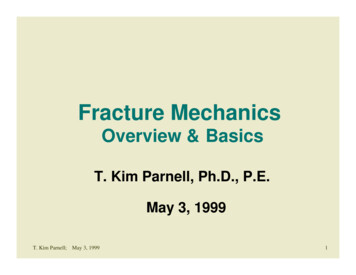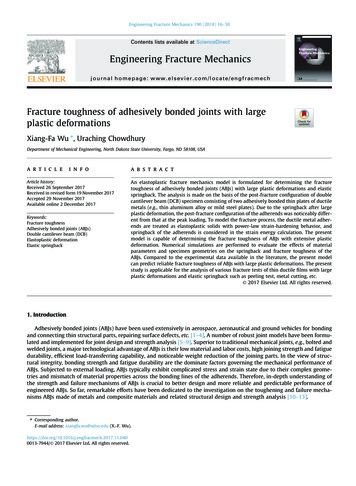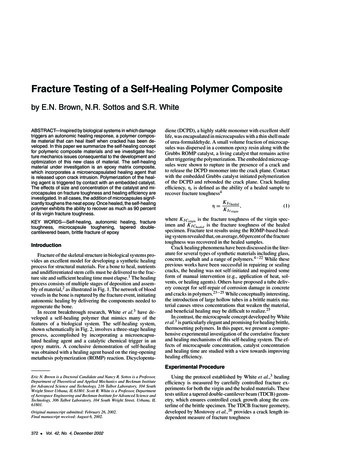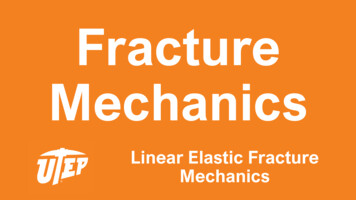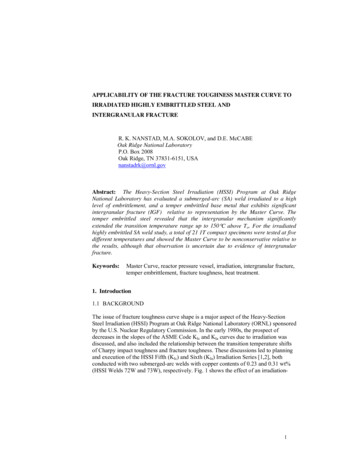
Transcription
APPLICABILITY OF THE FRACTURE TOUGHNESS MASTER CURVE TOIRRADIATED HIGHLY EMBRITTLED STEEL ANDINTERGRANULAR FRACTURER. K. NANSTAD, M.A. SOKOLOV, and D.E. McCABEOak Ridge National LaboratoryP.O. Box 2008Oak Ridge, TN 37831-6151, USAnanstadrk@ornl.govAbstract: The Heavy-Section Steel Irradiation (HSSI) Program at Oak RidgeNational Laboratory has evaluated a submerged-arc (SA) weld irradiated to a highlevel of embrittlement, and a temper embrittled base metal that exhibits significantintergranular fracture (IGF) relative to representation by the Master Curve. Thetemper embrittled steel revealed that the intergranular mechanism significantlyextended the transition temperature range up to 150 C above To. For the irradiatedhighly embrittled SA weld study, a total of 21 1T compact specimens were tested at fivedifferent temperatures and showed the Master Curve to be nonconservative relative tothe results, although that observation is uncertain due to evidence of intergranularfracture.Keywords:Master Curve, reactor pressure vessel, irradiation, intergranular fracture,temper embrittlement, fracture toughness, heat treatment.1. Introduction1.1 BACKGROUNDThe issue of fracture toughness curve shape is a major aspect of the Heavy-SectionSteel Irradiation (HSSI) Program at Oak Ridge National Laboratory (ORNL) sponsoredby the U.S. Nuclear Regulatory Commission. In the early 1980s, the prospect ofdecreases in the slopes of the ASME Code KIc and KIa curves due to irradiation wasdiscussed, and also included the relationship between the transition temperature shiftsof Charpy impact toughness and fracture toughness. These discussions led to planningand execution of the HSSI Fifth (KIc) and Sixth (KIa) Irradiation Series [1,2], bothconducted with two submerged-arc welds with copper contents of 0.23 and 0.31 wt%(HSSI Welds 72W and 73W), respectively. Fig. 1 shows the effect of an irradiation-1
Figure 1. Mean curve fits to HSSI Weld 73W KJc data normalized to RTNDTand showing effect of irradiation on curve shape.induced shift of 100 C on the mean fracture toughness curve fits for HSSI weld 73W.The results indicated a change in shape due to irradiation, although statistical analysisconcluded the slope change was significant at a 90% confidence level but not at a 95%confidence level. Fig. 2. shows results from Kaun and Koehring [3] in which theyFigure 2. Mean curve fits to KJc data from Kaun and Koehring showingsubstantial decrease in curve slope with increasing irradiation fluence.2
tested 4T specimens at different neutron fluences with fracture toughness transitiontemperature shifts up to about 170 C. As indicated on the figure, the slope of the curvefits decrease significantly at the higher fluences. The published paper does not providethe actual measured KIc data, so a statistical analysis is not possible. Regarding crackarrest toughness, results from the HSSI Sixth Irradiation Series resulted in a conclusionthat there was no apparent change in the shape of the mean curve fits to the KIa results.Those studies and others in the literature fit the data with, for example, three-parameterexponential functions in a manner that allowed for judgements regarding change incurve shape, but the methods are not consistent.1.2 THE MASTER CURVEThe technology associated with the Master Curve has the potential of more accuratedefining the position and shape of the ductile-to-brittle transition range for ferritic steels[4]. An integral part of the technology has been the observation that most grades offerritic steels share a common transition curve shape. This has been the underlyingassumption in the ASME code for almost 30 years regarding the form of lower-boundKIC and KIa curves [5]. However, a statistical rationale for construction of those curveswas not developed. On the other hand, the Master Curve analysis procedure has beendeveloped with statistical concepts, and has been justified using a physical rationale.Wallin [6,7] developed the Weibull-based statistical analysis and procedures forspecimen size normalization that resulted in a universal curve shape for cleavagefracture of ferritic steels. Equation 1 represents the three-parameter Weibull distributionfor failure probability in which two of the parameters are fixed, a minimum KJc of 20MPa m and a shape parameter of 4, where B is the thickness of tested specimens andBo is the reference thickness. Equation 2 represents the Master Curve normalized totemperature To, the temperature at which the median fracture toughness of a 1Tspecimen (the reference thickness Bo in equation (1) is 100 MPa m. B K 20 4 , (1) IPf 1 exp B o K o 20 K Jc ( median ) 30 70 exp[0.019(T To )] , (2)These developments then eventually evolved into a consensus test standard, ASTME 1921-97 [8], for determination of the parameter To, the background for which waspublished in reference [9]. There are now numerous publications in the literaturedemonstrating the applicability of the Master Curve to the cleavage fracture toughnessof ferritic steels, especially RPV steels (see, for example, refs. 10 and 11). Studies arenecessarily continuing, however, to investigate the phenomenological basis for theMaster Curve as well as the limitations of its applicability. For example, Rathbun andOdette [12] have recently completed a comprehensive experimental study with testspecimens of varying thicknesses and widths aimed at separating statistical effects andmechanical constraint.3
1.3 MASTER CURVE AND IRRADIATION-INDUCED EMBRITTLEMENTOther questions have been raised that challenge the universal aspect of the MasterCurve. A case in point is that steels of low upper-shelf toughness will prematurelytruncate their Master Curve trend, as demonstrated with the irradiated Midland ReactorRPV weld [11]. Cleavage crack initiation is assumed to be the controlling transitiontemperature mechanism, and microstructural imperfections have been demonstrated tobe the cleavage crack-triggering sources.[13] Usually, commercially produced steelsconform to this behavior and this characteristic, to a limited amount of transitiontemperature shift, has been shown to be unchanged by embrittlement mechanisms suchas irradiation damage. Sokolov and Nanstad [14] assembled and analyzed a fracturetoughness database relative to the Master Curve and showed that, although the overalldatabase of irradiated data indicated no significant deviation from the Master Curveshape, the subset of highly embrittled steels (those with transition temperature shifts of100 C or greater) within that database did reveal a shallower slope. These results areshown in Fig. 3, which shows the multiplier parameter inside the exponent of theequations and reveals the lower value for the metals with a T41J greater than 100EC.Thus, the results of Nanstad, et. al. on HSSI Weld 73W [1], those of Kaun andKoehring [3], and those of Sokolov and Nanstad [14] led to the HSSI investigation of ahighly embrittled steel described in this paper.Figure 3. Mean curve fits comparing curve shape for all irradiated data with that formetals with a high T41J.4
1.4 MASTER CURVE AND INTERGRANULAR FRACTUREAnother embrittlement mechanism that has not received sufficient attention relative tothe Master Curve is intergranular fracture (IGF). As mentioned above and as explicitlystated in E 1921, the Master Curve development was based on fracture toughnessresults from transgranular cleavage fracture. Some metallurgical phenomena, such astemper embrittlement, can lead to diffusion of solutes to or out of grain boundaries suchthat the boundaries are weakened. This fracture mode is typically associated withtemper embrittlement[15], a phenomenon that can lead to intergranular rather thantransgranular fracture. A number of low alloy steels have been identified as beingsusceptible to this particular type of embrittlement mechanism. On the other hand,reactor pressure vessel (RPV) steels tend to be relatively insensitive to temperembrittlement.[16] However, if the prior austenite grain diameter is nominally 65 µm[American Society for Testing and Materials (ASTM) E112] grain size 5) or larger,sensitivity to temper embrittlement can be shown after long-term exposure within thecritical temper embrittlement temperature range, which is about 400 to 600 C, atemperature well above the operating range for current light-water reactors, except inthe case of post-irradiation thermal annealing. This condition has been the subject ofstudy in a few recent experiments. For example, the heat treatment described inreference [17] was used on five heats of commercial RPV steels at ORNL. All weresensitized at high austenitization temperatures to obtain an ASTM grain size as large as0 to 00 (360 to 510 µm grain diameter). After embrittlement-aging at 450 C (842 F) for2000 h, Charpy impact transition temperature shifts, T, ranged from 35 to 145 C (63to 261 F). Another austenitization process used was a weld-cycle simulation, whichproduced a smaller average grain diameter, nominally 65 µm (ASTM E112, size 5).This embrittlement aging resulted in Charpy impact Ts of 56 to 133 C (101 to 239 F).Measurements of grain boundary composition demonstrated the significant increase ofphosphorus in the aged steel. The same five commercially made steels in the asreceived condition with ASTM grain sizes from 8 to 10, when embrittlement-aged,showed transition-temperature shifts from 0 to 64 C (0 to 115 F).Given the demonstrated potential to develop significant temper embrittlement inspecially heat treated commercial RPV steels by aging, the HSSI Program embarked ona project to investigate the potential for temper embrittlement in an irradiated andthermally annealed coarse grain weld heat-affected zone. Such potential wasdemonstrated in specially heat treated, irradiated, and thermally annealed model steelsby McElroy, et. al. [17] This study dramatically exhibited the issue of temperembrittlement in an RPV steel in that post-irradiation thermal annealing recovered thehardening but the ductile-brittle transition temperature was further increased andexhibited significant intergranular fracture. McCabe [16] utilized the electricalresistance method offered by the Gleeble system to prepare weld cycle simulated heataffected-zone specimens of one of the five as-received A 302 grade B (modified) steelsused in the thermal aging study. Charpy impact specimens were irradiated at 288 C to afluence of 1 1023 n/m2 ( 1 MeV). Nanstad et al. [18] showed that, although the steelin the as-received condition exhibited no intergranular fracture following irradiation,the simulated heat-affected-zone exhibited 10 to 20% intergranular fracture followingirradiation. Moreover, following post-irradiation thermal annealing at 460EC for 168 h,5
the material exhibited predominantly intergranular fracture ( 75%). These results areshown in the scanning electron fractographs in Fig. 4. The results of this study lendfurther support for the need to investigate the relationship between intergranularfracture and the Master Curve.Figure 4. Gleeble simulated heat-affected-zone in A302B (mod) steel exhibited predominantlyintergranular fracture after irradiation at 288EC to 1 1023 n/m2 and annealing at460EC/168 h.2. Description of MaterialsAs stated earlier, the A 302 grade B (modified) steel was one of five steels tested in aprevious thermal aging program [16]. The chemical composition and the tensilestrengths of the steel in the final aged condition are provided in Table I; the heattreatment schedule is discussed in the next section. The phosphorus content in the steelis not particularly high, although it exhibited significant sensitivity to the temperembrittlement treatment. Additional properties of this material are available inreferences [16 and 19]. The submerged-arc weld, designated KS-01, was provided byMPA in Stuttgart, Germany, collaborators in the irradiation study. This weld wasspecially fabricated with the intent to produce a high-strength weld metal with highradiation-sensitivity. As shown in Table I, the high strength was achieved and highradiation sensitivity, discussed later, was achieved due to the high contents of copper,nickel, and phosphorus.TABLE I. Chemical Composition and Tensile Strength for A302 grade B modified steel and SA WeldYS /UTSaCbMnPSSiNi(MPa)A 302B (mod)c593/7300.261.42 0.010 0.0140.17 0.53SA Weld KS-01dU: 600/7000.061.64 0.017 0.0120.18 1.23I: 826/900aYS and UTS are tensile yield strength and ultimate tensile strength, respectively.bAll chemical composition measurements are in wt%.cCondition after austenitization, PWHT, and thermal aging at 460EC for 2000 h.dU: Unirradiated condition; I: Irradiated conditionMaterialCrMoCu0.090.470.500.700.170.376
3. Temper Embrittlement Heat Treatment for Intergranular Fracture StudyThe material preparation for the present experiment was as follows: austenitize at1200 C (2192 F) for 30 min, oil quench and PWHT at 615EC for 24 h. The resultinggrain size was ASTM 1.5, or a grain diameter of about 210 µm. For the agingtreatment, specimens were heat treated at 460EC for 2000 h. The before-and-afterembrittlement-aging Charpy transition curves are shown in Fig. 5. The transitiontemperature shift at the 41-J level was 122 C (252 F). A total of 10 0.5T compactspecimens were tested in the unaged condition, while 50 compact specimens, 0.5T,1.0T, and 2T, were machined from the temper embrittled steel and tested with the E1921 procedure. Fracture toughness test specimens classified as 2T are more accuratelydenoted as 1.875T. These specimens had to be made slightly under size because theywere machined from previously tested 4T specimens [16].Figure 5. Charpy impact energy vs temperature data and curve fits for A302B(mod) steel after austenitization at 1200EC, oil quenching, and PWHT at615EC/24 h: without aging and after aging at 460EC/2000 h.4. Irradiation Conditions for the Highly Embrittled Weld StudyThe SA Weld KS-01 was irradiated in the HSSI Irradiation/Anneal/Reirradiation (IAR)facility at the University of Michigan Ford Nuclear Reactor (FNR). Charpy, tensile,precracked Charpy, and 1T compact specimens were irradiated at 288EC 2EC and aneutron flux of about 0.6 1016 n/m2 to a neutron fluence of about 0.8 1023 n/m2 ( 1MeV). A total of 21 1T compact specimens were irradiated and tested with the E 1921procedure. Irradiated data, mostly Charpy and tensile, were available from MPA toprovide guidance for selecting a desirable fluence. The target fluence was then selected7
to result in a To after irradiation to be equal or slightly higher than 132EC (270EF). Thistemperature is the screening criterion reference temperature for pressurized thermalshock analysis of axial flaws in RPVs in the United States. The Charpy, tensile, and 1Tcompact specimen data are discussed in this paper.5. Test Results5.1 INTERGRANULAR FRACTURE OF TEMPER EMBRITTLED STEELThe principal objective of the experiment was to determine whether fracture toughnessdata for ferritic steels that fail in an intergranular fracture mode follow the MasterCurve shape. The first step was to establish the temperature, To, at which the medianKJC is 100 MPa m for the unaged and embrittlement-aged materials. The tests for thispurpose were made at !125 and !100EC (!193 and !148EF), respectively. Theremaining specimens were used to establish the transition curve shape. Fig. 6 shows theresults for the aged material, involving intergranular fracture, in the form of as-KJc, MPa m 0.54003000.5T1.0T2.0T2001000-150 -100-50050100150200TEST TEMPERATURE, CFigure 6. As-measured KJc data for temper embrittled A302B (mod) steel. Allresults shown represent specimens that failed by intergranular fracture.measured KJC, at each test temperature.Figure 7 shows the median KJc adjusted results at each test temperature. The MasterCurve is keyed to the first as-embrittled To temperature determined by testing at!125EC. The one test at 50EC (122EF) represents an attempt to find the upper-shelftemperature. Upper-shelf performance was expected from this specimen because fullKR-curve data had been produced in two out of the five tests made at 24EC (75EF). The2T specimen tested at 50EC instead showed crack pop-in at 173 MPa m, which wasfollowed by stable crack growth up to 283 MPa m and then crack instability. Hence,the transition range for the temper-embrittled material extends from below !100EC toabove 50EC, significantly exceeding that for materials with conventional transition-8
Figure 7. Median KJc values for temper embrittled A302B (mod) steel afternormalization to 1T equivalence compared to Master Curve based on dataat the three lowest test temperatures.range mechanisms. A similar observation has been made by Kantidis, Marini, andPineau for temper embrittled A533 grade B class steel [20]. When the transition rangeis controlled by a cleavage-to-ductile rupture mechanism, the transition range betweenTo temperature and the upper shelf is of the order of 75 to 80EC. Four 0.5T compactspecimens were subsequently tested at 100EC. One specimen exhibited a pop-in wellout on the J-R curve, while the other three specimens showed fully ductile behavior butwith evidence of ductile instabilities. Table II provides a summary of the various testresults for the A302B (modified) steel in the as-received, heat treated, and agedconditions.5.1.1. Fracture Surface FeaturesIt was of interest to know whether the ratio of ductile versus intergranular fracture areaschanges as upper shelf temperatures are approached. Figure 8 is an SEM fractographfor a test at 24EC (75EF). At 0E and 24EC ( 32 and 75EF), the fracture surfaces areidentical, with almost 100% being intergranular. At !100EC (!148EF), a smallpercentage, on the order of 5%, is cleavage-like with the balance being intergranular.However, at 24EC (75EF) there was some slow-stable crack growth that preceded thespecimen failure by intergranular fracture. Figure 8 shows the slow stable growth area9
TABLE II. Transition temperature summary for intergranular fracture study.Property/ConditionTensile Strengthc (MPa)Yield StrengthUltimate StrengthCVN Propertiesb (ºC)ToT41JT28JCVN Upper Shelf Energy (J)NDT (ºC)Fracture Toughness PropertiesMaster Curve To (ºC)JIc (kJ/m2)TmodASTM Grain SizeAsReceivedAus PWHTaAus PWHT -4125--88212969-140266711.5-100199861.5aAus means austenitize at 1200EC for 30 min. and oil quench. PWHT is post-weld heat treat at 615EC/24.Same condition as in footnote a, plus aging at 2000 h at 450EC.Room-temperature tests.dThis To stands for temperature at mid-Charpy impact transition energy.bcnear the left border of the figure, with the remaining area being intergranular fracture,while figure 9 shows a magnification of the area of ductile fracture.Figure 8. Scanning electron fractograph of a0.5T compact specimen of the temperembrittled A302B (mod) steel tested at 24C,with nearly complete intergranular fracture.Figure 9. Scanning electronfractograph of the stable crackgrowth area preceding brittleintergranular fracture of the specimenAs mentioned before, the intergranular fracture portion of Fig. 8 does not appear to bemuch different from those at significantly lower temperatures. These fractographsillustrate why intergranular fracture causes such a delayed development of upper-shelfbehavior, viewed in terms of fracture appearance and fracture toughness.10
5.1.2 Fracture Toughness CharacteristicsThe present data have demonstrated that the transition-range behavior of steels that areembrittled by intergranular mechanisms is different from that for steels whosetransition-range mechanisms are cleavage-to-ductile tearing. The correlations withCharpy data developed in the latter case do not apply in the former case. For example,embrittlement by neutron irradiation still results in the cleavage-to-ductile transition,and the transition-temperature shift occurs with little or no change in Master Curveshape. Also, there is some reduction of upper-shelf ductile-tearing resistance. At uppershelf temperatures, both Charpy impact energy and KR-curve fracture toughnessmechanisms are diminished by irradiation. The present intergranular damagemechanism affects only transition temperature shift. Examination of the data show thatthere is no difference in KR-curves caused by transforming the commercially producedmaterial, by the heat treatment including aging, into an enlarged grain intergranularsensitized steel. The as-embrittled Charpy impact transition temperature, however, isconsiderably affected, comparing !9EC to 42EC (16EF to 108EF), as indicated by TableII. Comparison of KR-curves before and after embrittlement aging (large prior austenitegrains) show only a slight decrease in the resistance curve for the aged material. In thiscase, the initial Charpy impact transition temperature was !87EC (!125EF) and, aspreviously mentioned, that for the aged condition was 42EC (108EF). The one featurethat intergranular and cleavage fracture modes have in common is that side-grooving ofspecimens reduces the fracture toughness described in terms of KR-curve development[16, 18]. The effect on the intergranular material seems to be quite severe.5.2 IRRADIATED HIGHLY EMBRITTLED SUBMERGED-ARC WELDFollowing irradiation, Charpy impact, tensile, and 1T compact specimens of weld KS01 were tested. Fig. 10 shows the Charpy impact data in both the unirradiated andirradiated conditions. The 41J temperature shift was 169EC, while the upper-shelfdecreased from 124 to 78 J, a decrease of 37%. Fig. 11 shows the yield and ultimatetensile strengths in both conditions. At room temperature, the yield strength increasedfrom 600 to 826 MPa, an increase of 38%.The ratio of Charpy shift in degrees centigrade and the increase in yield strength inMPa is 0.75, a value in close agreement with the 0.65 result reported by Odette,Lombrozo, and Wullaert [21], and with the value of 0.70 for low upper-shelf weldsreported by Nanstad and Berggren for low upper-shelf welds. [22] Fig. 12 (a) shows themedian KJc results at the lowest three test temperatures and the Master Curve fit tothose three values. Fig. 12 (b) shows all the KJc data at all test temperatures and asimilar effect as exhibited by the temper embrittled steel; that is, brittle fracture resultsat temperatures further above To than expected (To 63EC), and a leveling off of theKJc data at about 110 MPa m. Taking the To determination from the curve fit in11
Fig 12 (a), the To was about 160EC. Scanning electron fractography revealed evidenceof intergranular fracturemixed with cleavagefracture in the irradiatedspecimens. The cleavagefracture mode waspredominant, but theintergranular fracture wasestimated to be 10 to 20%.Interestingly, scanningelectron fractography ofthe unirradiated fracturetoughness specimens alsoshowed a similar amountof intergranular fracture,although the unirradiateddata did not exhibit similarFigure 10. Charpy impact data for submerged-arcbrittle fracture at highweld KS-01 in the unirradiated and irradiatedtemperatures beyond To.conditions.This result ratherconfounds the issue of theirradiation-induced changein curve shape and is stillunder evaluation. A moredetailed presentation ofthis study is published inref. [23].6. DiscussionThe original hypothesisthat the fracture toughnessof materials that fail due tointergranular fracture mayFigure 11. Yield and ultimate tensile strengths vstemperature for submerged-arc weld KS-01 in thenot be appropriatelyunirradiated and irradiated conditions.represented by the MasterCurve is supported by theresults discussed in thispaper. The Master Curvehas been assumed to be universal for all ferritic steels, as limited to a certain yieldstrength range. [8] The supporting data were for steels that displayed cleavage-toductile mechanisms in both unirradiated and irradiated conditions. Intergranularfracture is principally associated with temper-embrittlement (TE) damage, a mechanismthat is not usually attributed to Western-type RPV steels. Commercially manufactured12
RPV steels with prior-austenite grain sizes that range from 8 to 11 are not subject tosignificant TE damage.The present experimental results illustrated in Fig. 7 have demonstrated thatintergranular fracture is in fact unique from the standpoint of transition-range behavior.Although there was a moderate fracture toughness increase over a 150EC (270EF)transition range, there was almost no change in fractographic appearance over the sametemperature range. This suggests that there is no operative weakest-link triggeringmechanism governing intergranular fracture. Of additional interest is the fact that theMaster Curve To temperature shift was only 40EC ( 72EF) in a material that had a122EC (207EF) Charpy impact transition-temperature shift. Fig. 13 shows a comparison(a)(b)Figure 12. Fracture toughness, KJc, data for submerged-arc weld KS-01 inthe irradiated condition (a shows median values at the lowest threetemperatures with Master Curve fit to those values; (b) shows all asmeasured data compared with Master Curve 5 and 95% tolerance bounds.13
of To vs T41J for a database of RPV steels [14] and the A302B (mod.) steel in threeconditions. This relationship for the steel falls within the database scatter band for theas-received and austenized/PWHT conditions. However, that for the aged condition(i.e., temper embrittled) falls well outside the scatter band. Hence, there was abreakdown in the To vs Charpy impact curve correlations that have been developed forsteels with cleavage operative mechanisms.Evidence of this correlation breakdown was also noted in Ref. [20]. Figure 8 shows thatthe relation between fracture toughness and temperature appears to follow the MasterCurve until fracture toughness is about 150 MPa m , but then levels off just above thatvalue. Despite the leveling off of fracture toughness, the fracture appearance continuesto be predominantly intergranular rather than completely ductile. For this material, evenat 100EC, one of four specimens exhibited an audible and relatively large pop-ininstability.Figure 13. Comparison of fracture toughness transition temperature To (labeled T100here) and Charpy T41J for the A302B (mod) steel in three conditions with the RPVsteels database from Ref. [14]., showing that the aged steel falls well outside of the95% scatter band of 40ºC.The extreme intergranular condition created in the present work does not representmore realistic cases involving considerably lower percentages of intergranularseparation mixed with cleavage. However, the present work does suggest that the Tembrittlement-transition-temperature shift as measured by Charpy impact curves may14
not be a reliable indicator for evaluations of changes in fracture-mechanics propertiesfor temper-embrittled steels if intergranular fracture occurs.This latter case of mixed intergranular and cleavage fracture applies to the irradiatedKS-01 submerged-arc weld. The evidence of some curve shape change reported forHSSI weld 73W by Nanstad, et. al. [1] was represented by all cleavage fractures withno intergranular fracture. Although Kaun and Koehring [3] reported significant curveshape changes, the fracture modes were not reported. The KS-01 irradiated resultsindicate that the Master Curve applies to a limited extent such that brittle fracture mayoccur at temperatures well above To. In this case, however, it is difficult to separate theeffects of irradiation from the 10 to 20% intergranular fracture observed on the fracturesurfaces. On the other hand, the transition temperature shifts of the Charpy impacttoughness and the fracture toughness were in good agreement (160 vs 169EC), unlikethe temper embrittled steel where the difference was very large ( 40 vs 122EC). Thismay be an indication that intergranular fracture at the 10 to 20% level did not play asignificant role in the fracture toughness tests. The very high transition temperatureshifts lead to a significant reduction in the Charpy upper-shelf toughness such that theKS-01 steel behaves similar to other low-upper shelf steels by exhibiting low ductileinitiation fracture toughness. The difference is that the onset of brittle fracture beyondthe JIc toughness seems to result in lower than expected values of KJc, and it is thisobservation that results in fracture toughness values outside of the Master Curvetolerance bounds. This behavior may be due to the influence of intergranular fracture.7. Summary and ConclusionsTwo different RPV steels, one in the temper embrittled condition and the other in theirradiated condition, have been tested to obtain fracture toughness data and the resultswere evaluated relative to the fracture toughness Master Curve.1. An A302 grade B (modified) steel plate was given an austenitization treatment thatwas needed to create 100% intergranular fracture. Temper-embrittlement aging at450EC (482EF) for 2000 h resulted in a transition-temperature shift from !73EC to42EC (!99EF to 108EF) as measured by Charpy impact curves, and from !140EC to!100EC (! 220EF to !148EF) as measured by Master-Curve-based To temperatures.2. An original hypothesis that the transition-range fracture toughness versustemperature curve for materials fracturing by intergranular fracture might differ fromthat for the cleavage mode proved to be correct.3. The occurrence of predominantly intergranular fracture extended the transition rangeof temperature between lower bound and upper-shelf behavior by a factor of at least 2with respect to that for a typical cleavage-transition range.4. The difference found between the Charpy-curve T and the fracture-mechanicsbased To implies that correlations between the two, based on cleavage data, are notapplicable when intergranular fracture is the predominant mode of fracture. A15
remaining issue, however, is the propensity for some RPV s
Abstract: The Heavy-Section Steel Irradiation (HSSI) Program at Oak Ridge National Laboratory has evaluated a submerged-arc (SA) weld irradiated to a high level of embrittlement, and a temper embrittled base metal that exhibits significant intergranular fracture (IGF) relative to representation by the Master Curve. The


